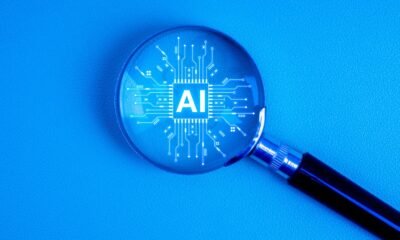AI Research
Refining AI perspectives: assessing the impact of ai curricular on medical students’ attitudes towards artificial intelligence | BMC Medical Education

Abbaoui W, Retal S, El Bhiri B, Kharmoum N, Ziti S. Towards revolutionizing precision healthcare: a systematic literature review of artificial intelligence methods in precision medicine. Inf Med Unlocked. 2024;46:101475. https://doi.org/10.1016/j.imu.2024.101475.
Abid A, Murugan A, Banerjee I, Purkayastha S, Trivedi H, Gichoya J. AI education for fourth-year medical students: two-year experience of a web-based, self-guided curriculum. JMIR Med Educ. 2024;10:e46500. https://doi.org/10.2196/46500.
Ahmad MN, Abdallah SA, Abbasi SA, Abdallah AM. Student perspectives on the integration of artificial intelligence into healthcare services. Digit Health. 2023;9:20552076231174096. https://doi.org/10.1177/20552076231174095.
Akingbola A, Adeleke O, Idris A, Adewole O, Adegbesan A. Artificial intelligence and the dehumanization of patient care. J Med Surg Public Health. 2024;3:100138. https://doi.org/10.1016/j.glmedi.2024.100138.
Alam F, Lim MA, Zulkipli IN. Integrating AI in medical education: embracing ethical usage and critical understanding. Front Med. 2023;10:1279707. https://doi.org/10.3389/fmed.2023.1279707.
Albadrani BA, Abdel-Raheem MA, Al-Farwachi MI. Artificial intelligence in veterinary care: a review of applications for animal health. Egypt J Vet Sci. 2024;55(6):1725–36. https://doi.org/10.21608/ejvs.2024.260989.1769.
Al Hadithy ZA, Al Lawati A, Al-Zadjali R, Al Sinawi H. Knowledge, attitudes, and perceptions of artificial intelligence in healthcare among medical students at sultan Qaboos university. Cureus. 2023;15(9):e44887. https://doi.org/10.7759/cureus.44887.
Alowais SA, Alghamdi SS, Alsuhebany N, Alqahtani T, Alshaya AI, Almohareb SN, Aldairem A, Alrashed M, Saleh KB, Badreldin HA, Al Yami MS, Al Harbi S, Albekairy AM. Revolutionizing healthcare: the role of artificial intelligence in clinical practice. BMC Med Educ. 2023;23(1):689. https://doi.org/10.1186/s12909-023-04698-z.
Alwadani F, Lone A, Hakami M, Moria AH, Alamer W, Alghirash RA, Alnawah AK, Hadadi AS. Attitude and understanding of artificial intelligence among Saudi medical students: an online cross-sectional study. J Multidiscip Healthc. 2024. https://doi.org/10.2147/JMDH.S455260.
Amoozadeh M, Daniels D, Nam D, Kumar A, Chen S, Hilton M, Ragavan SS, Alipour MA. Trust in generative AI among students: An exploratory study. In Proceedings of the 55th ACM Technical Symposium on Computer Science Education V. 2024;1 (pp. 67-73). https://doi.org/10.1145/3626252.3630842
Appleby RB, Basran PS. Artificial intelligence in veterinary medicine. J Am Vet Med Assoc. 2022;260(8):819–24. https://doi.org/10.2460/javma.22.03.0093.
Bates DW, Levine D, Syrowatka A, Kuznetsova M, Craig KJT, Rui A, Jackson GP, Rhee K. The potential of artificial intelligence to improve patient safety: a scoping review. NPJ Digit Med. 2021;4:54. https://doi.org/10.1038/s41746-021-00423-6.
Batra AM, Reche A. A new era of dental care: harnessing artificial intelligence for better diagnosis and treatment. Cureus. 2023;15(11):e49319. https://doi.org/10.7759/cureus.49319.
Baurasien BK, Alareefi HS, Almutairi DB, Alanazi MM, Alhasson AH, Alshahrani AD, Almansour SA, Alshagag ZA, Alqattan KM, Alotaibi HM. Medical errors and patient safety: Strategies for reducing errors using artificial intelligence. Int J Health Sci. 2023;7(S1):3471–87. https://doi.org/10.53730/ijhs.v7nS1.15143.
Benzinger L, Ursin F, Balke WT, Kacprowski T, Salloch S. Should artificial intelligence be used to support clinical ethical decision-making? A systematic review of reasons. BMC Med Ethics. 2023;24:48. https://doi.org/10.1186/s12910-023-00929-6.
Bewersdorff A, Zhai X, Roberts J, Nerdel C. Myths, mis-and preconceptions of artificial intelligence: a review of the literature. Comput Educ. 2023;4:100143. https://doi.org/10.1016/j.caeai.2023.100143.
Bisdas S, Topriceanu CC, Zakrzewska Z, Irimia AZ, Shakallis L, Subhash J, Casapu MM, Leon-Rojas J, dos Santos DP, Andrews DM, Zeicu C, Bouhuwaish AM, Lestari AN, Abu-Ismail L, Sadiq AS, Khamees A, Mohammed KMG, Williams E, Omran AI, Ismail DYA, Ebrahim EH. Artificial intelligence in medicine: a multinational multi-center survey on the medical and dental students’ perception. Front Public Health. 2021;9:795284. https://doi.org/10.3389/fpubh.2021.795284.
Buchlak QD, Esmaili N, Bennett C, Farrokhi F. Natural language processing applications in the clinical neurosciences: a machine learning augmented systematic review. Machine Learn Clin Neurosci. 2022;134:277–89. https://doi.org/10.1007/978-3-030-85292-4_32.
Burney IA, Ahmad N. Artificial Intelligence in medical education: a citation-based systematic literature review. J Shifa Tameer-E-Millat Univ. 2022;5(1):43–53. https://doi.org/10.32593/jstmu/Vol5.Iss1.183.
Busch F, Hoffmann L, Truhn D, Ortiz-Prado E, Makowski MR, Bressem KK, Adams LC. Global cross-sectional student survey on AI in medical, dental, and veterinary education and practice at 192 faculties. BMC Med Educ. 2024;24(1):1066. https://doi.org/10.1186/s12909-024-06035-4.
Cai Z, Fan X, Du J. Gender and attitudes toward technology use: a meta-analysis. Comput Educ. 2017;105:1–13. https://doi.org/10.1016/j.compedu.2016.11.003.
Çalışkan SA, Demir K, Karaca O. Artificial intelligence in medical education curriculum: an e-Delphi study for competencies. PLoS ONE. 2022;17(7):e0271872. https://doi.org/10.1371/journal.pone.0271872.
Chan KS, Zary N. Applications and challenges of implementing artificial intelligence in medical education: integrative review. JMIR Med Educ. 2019;5(1):e13930. https://doi.org/10.2196/13930.
Charow R, Jeyakumar T, Younus S, Dolatabadi E, Salhia M, Al-Mouaswas D, Anderson M, Balakumar S, Clare M, Dhalla A, Gillan C, Haghzare S, Jackson E, Lalani N, Mattson J, Peteanu W, Tripp T, Waldorf J, Williams S, Tavares W, Wiljer D. Artificial intelligence education programs for health care professionals: scoping review. JMIR Med Educ. 2021;7(4):e31043. https://doi.org/10.2196/31043.
Choudhury A, Asan O. Role of artificial intelligence in patient safety outcomes: systematic literature review. JMIR Med Inform. 2020;8(7):e18599. https://doi.org/10.2196/18599.
Chustecki M. Benefits and risks of AI in health care: narrative review. Interact J Med Res. 2024;13(1):e53616. https://doi.org/10.2196/53616.
Cohen A, Soffer T, Henderson M. Students’ use of technology and their perceptions of its usefulness in higher education: international comparison. J Comput Assist Learn. 2022;38(5):1321–31. https://doi.org/10.1111/jcal.12678.
Dave M, Patel N. Artificial intelligence in healthcare and education. Br Dent J. 2023;234(10):761–4. https://doi.org/10.1038/s41415-023-5845-2.
Davenport T, Kalakota R. The potential for artificial intelligence in healthcare. Future Healthc J. 2019;6(2):94–8. https://doi.org/10.7861/futurehosp.6-2-94.
De Panfilis L, Peruselli C, Tanzi S, Botrugno C. AI-based clinical decision-making systems in palliative medicine: ethical challenges. BMJ Support Palliat Care. 2023;13(2):183–9. https://doi.org/10.1136/bmjspcare-2021-002948.
Duan S, Liu C, Rong T, Zhao Y, Liu B. Integrating AI in medical education: a comprehensive study of medical students’ attitudes, concerns, and behavioral intentions. BMC Med Educ. 2025;25:599. https://doi.org/10.1186/s12909-025-07177-9.
Ennab M, Mcheick H. Enhancing interpretability and accuracy of AI models in healthcare: a comprehensive review on challenges and future directions. Front Robot AI. 2024;11:1444763. https://doi.org/10.3389/frobt.2024.1444763.
Esmaeilzadeh P. Challenges and strategies for wide-scale artificial intelligence (AI) deployment in healthcare practices: a perspective for healthcare organizations. Artif Intell Med. 2024;151:102861. https://doi.org/10.1016/j.artmed.2024.102861.
Esteva A, Robicquet A, Ramsundar B, Kuleshov V, DePristo M, Chou K, Cui C, Corrado G, Thrun S, Dean J. A guide to deep learning in healthcare. Nat Med. 2021;25(1):24–9. https://doi.org/10.1038/s41591-018-0316-z.
Feigerlova E, Hani H, Hothersall-Davies E. A systematic review of the impact of artificial intelligence on educational outcomes in health professions education. BMC Med Educ. 2025;25:129. https://doi.org/10.1186/s12909-025-06719-5.
Franco D’Souza R, Mathew M, Mishra V, Surapaneni KM. Twelve tips for addressing ethical concerns in the implementation of artificial intelligence in medical education. Med Educ Online. 2024;29(1):2330250. https://doi.org/10.1080/10872981.2024.2330250.
Gandhi R, Parmar A, Kagathara J, Lakkad D, Kakadiya J, Murugan Y. Bridging the artificial intelligence (AI) divide: do postgraduate medical students outshine undergraduate medical students in AI readiness? Cureus. 2024;16(8):e67288. https://doi.org/10.7759/cureus.67288.
Ghaffari M, Zhu Y, Shrestha A. A review of advancements of artificial intelligence in dentistry. Dentistry Review. 2024;4(2):100081. https://doi.org/10.1016/j.dentre.2024.100081.
Gong B, Nugent JP, Guest W, Parker W, Chang P, Khosa F, Nicolaou S. Influence of artificial intelligence on Canadian medical students’ preference for radiology specialty. Acad Radiol. 2019;26(4):566–77. https://doi.org/10.1016/j.acra.2018.10.007.
Gordon M, Daniel M, Ajiboye A, Uraiby H, Xu NY, Bartlett R, Hanson J, Haas M, Spadafore M, Grafton-Clarke C, Gasiea RY, Michie C, Corral J, Kwan B, Thammasitboon S. A scoping review of artificial intelligence in medical education: BEME guide no. 84. Med Teach. 2024;46(4):446–70. https://doi.org/10.1080/0142159X.2024.2314198.
Grunhut J, Marques O, Wyatt ATM. Needs, challenges, and applications of artificial intelligence in medical education curriculum. JMIR Medical Education. 2021;8(2):e35587. https://doi.org/10.2196/35587.
Guo J, Li B. The application of medical artificial intelligence technology in rural areas of developing countries. Health Equity. 2018;2(1):174–81. https://doi.org/10.1089/heq.2018.0037.
Güven GÖ, Yilmaz Ş, Inceoğlu F. Determining medical students’ anxiety and readiness levels about artificial intelligence. Heliyon. 2024;10(4): e25894. https://doi.org/10.1016/j.heliyon.2024.e25894.
Hair JF, Black WC, Babin BJ, Anderson RE. Multivariate Data Analysis (7th Edition). Pearson. 2012.
Hamilton, V., Brisco, R., & Grierson, H. How can AI support the creation of novel ideas in product design. In 26th International Conference on Engineering and Product Design Education: Rise of the Machines: Design Education in the Generative AI Era. The Design Society. 2024:133-138. https://doi.org/10.35199/EPDE.2024.23.
Hosny A, Parmar C, Quackenbush J, Schwartz LH, Aerts HJ. Artificial intelligence in radiology. Nat Rev Cancer. 2018;18(8):500–10. https://doi.org/10.1038/s41568-018-0016-5.
Hui ML, Sacoransky E, Chung A, Kwan BY. Exploring the integration of artificial intelligence in radiology education: a scoping review. Curr Probl Diagn Radiol. 2024. https://doi.org/10.1067/j.cpradiol.2024.10.012.
Iacus SM, King G, Porro G. Multivariate matching methods that are monotonic imbalance bounding. J Am Stat Assoc. 2011;106(493):345–61. https://doi.org/10.1198/jasa.2011.tm09599.
Iweuno BN, Orekha P, Ojediran O, Imohimi E, Adu-Twum HT. Leveraging Artificial Intelligence for an inclusive and diversified curriculum. World J Adv Res Rev. 2024;23(2):1579–90. https://doi.org/10.30574/wjarr.2024.23.2.2440.
Jalal R, Prajapati AK, Bora P. Exploring the intersection of psychology and artificial intelligence: Implications and challenges. In Artificial intelligence: A modern approach in different fields (pp. 41–52). Laxmi Book Publication. 2024.
Jamal A, Solaiman M, Alhasan K, Temsah MH, Sayed G, Soliman M. Integrating ChatGPT in medical education: adapting curricula to cultivate competent physicians for the AI era. Cureus. 2023;15(8):e43036. https://doi.org/10.7759/cureus.43036.
Jiang F, Jiang Y, Zhi H, Dong Y, Li H, Ma S, Wang Y, Dong Q, Shen H, Wang Y. Artificial intelligence in healthcare: past, present and future. Stroke Vasc Neurol. 2017;2(4):230–43. https://doi.org/10.1136/svn-2017-000101.
Jongsma KR, van Solinge WW, Haitjema S. Eight misconceptions about AI in healthcare. Ned Tijdschr Geneeskd. 2023;167:D7578–D7578.
Kansal R, Bawa A, Bansal A, Trehan S, Goyal K, Malhotra K. Differences in knowledge and perspectives on the usage of artificial intelligence among doctors and medical students of a developing country: a cross-sectional study. Cureus. 2022;14(1):e21434. https://doi.org/10.7759/cureus.21434.
Khalifa M, Albadawy M. AI in diagnostic imaging: revolutionising accuracy and efficiency. Comput Methods Programs Biomed Update. 2024;5:100146. https://doi.org/10.1016/j.cmpbup.2024.100146.
Khalifa M, Albadawy M, Iqbal U. Advancing clinical decision support: the role of artificial intelligence across six domains. Comput Methods Programs Biomed Update. 2024;5:100142. https://doi.org/10.1016/j.cmpbup.2024.100142.
Khan MJ, Lajber M, Bilal N, Khan S, Ahmad A. The barriers and solution to Artificial intelligence adoption in medical education: a qualitative study. J Saidu Med College Swat. 2024;14(4):341–7. https://doi.org/10.52206/jsmc.2024.14.4.957.
Khogali HO, Mekid S. Perception and ethical challenges for the future of AI as encountered by surveyed new engineers. Soc (Basel). 2024;14(12):271. https://doi.org/10.3390/soc14120271.
Kline RB. Principles and Practice of Structural Equation Modeling. Guilford Press; 2005.
Kimmerle J, Timm J, Festl-Wietek T, Cress U, Herrmann-Werner A. Medical students’ attitudes toward AI in medicine and their expectations for medical education. J Med Educ Curric Dev. 2023;10:23821205231219344. https://doi.org/10.1101/2023.07.19.23292877.
Krive J, Isola M, Chang L, Patel T, Anderson M, Sreedhar R. Grounded in reality: artificial intelligence in medical education. JAMIA Open. 2023;6(2):00ad037. https://doi.org/10.1093/jamiaopen/ooad037.
Lamem MFH, Sahid MI, Ahmed A. Artificial intelligence for access to primary healthcare in rural settings. J Med Surg Public Health. 2024;5:100173. https://doi.org/10.1016/j.glmedi.2024.100173.
Lee J, Wu AS, Li D, Kulasegaram K. Artificial intelligence in undergraduate medical education: a scoping review. Acad Med. 2021;96(11S):S62–70. https://doi.org/10.1097/ACM.0000000000004291.
Locke S, Bashall A, Al-Adely S, Moore J, Wilson A, Kitchen GB. Natural language processing in medicine: a review. Trends Anaesth Crit Care. 2021;38:4–9. https://doi.org/10.1016/j.tacc.2021.02.007.
Li M, Jiang Y, Zhang Y, Zhu H. Medical image analysis using deep learning algorithms. Front Public Health. 2023;11:1273253. https://doi.org/10.3389/fpubh.2023.1273253.
Li Q, Qin Y. AI in medical education: medical student perception, curriculum recommendations and design suggestions. BMC Med Educ. 2023;23(1):852. https://doi.org/10.1186/s12909-023-04700-8.
Longoni C, Bonezzi A, Morewedge CK. Resistance to medical artificial intelligence. J Consum Res. 2019;46(4):629–50. https://doi.org/10.1093/jcr/ucz013.
Lund BD, Mannuru NR, Agbaji DA. AI anxiety and fear: A look at perspectives of information science students and professionals towards artificial intelligence. J Inf Sci. 2024. https://doi.org/10.1177/01655515241282001.
Ma Y, Song Y, Balch JA, Ren Y, Vellanki D, Hu Z, Brennan M, Kolla S, Guan Z, Armfield B, Ozrazgat-Baslanti T, Rashidi P, Loftus TJ, Bihorac A, Shickel B. (2024). Promoting AI competencies for medical students: a scoping review on frameworks, programs, and tools. arXiv preprint arXiv:2407.18939. https://doi.org/10.48550/arXiv.2407.18939.
Macruz F. Misconceptions in the health technology industry that are delaying the translation of artificial intelligence technology into relevant clinical applications. Radiol Bras. 2021;54:243–5. https://doi.org/10.1590/0100-3984.2020.0151.
Malerbi FK, Nakayama LF, Gayle Dychiao R, Zago Ribeiro L, Villanueva C, Celi LA, Regatieri CV. Digital education for the deployment of artificial intelligence in health care. Journal of Medical Internet Research. 2023;25:e43333. https://doi.org/10.2196/43333.
Markus KA. Principles and practice of structural equation modeling by Rex B. Kline. Struct Equ Modeling A Multidiscip J. 2012;19(3):509–12. https://doi.org/10.1080/10705511.2012.687667.
Masters K. Artificial intelligence in medical education. Med Teach. 2019;41(9):976–80. https://doi.org/10.1080/0142159X.2019.1595557.
McCoy L, Nagaraj S, Morgado F, Harish V, Das S, Celi L. What do medical students actually need to know about artificial intelligence? NPJ Digital Med. 2020;3(1):86. https://doi.org/10.1038/s41746-020-0294-7.
Mehta N, Harish V, Bilimoria K, Morgado F, Ginsburg S, Law M, Das S. Knowledge of and attitudes on artificial intelligence in healthcare: A provincial survey study of medical students. Medrxiv, 2021–01. 2021. https://doi.org/10.1101/2021.01.14.21249830
Melisa R, Ashadi A, Triastuti A, Hidayati S, Salido A, Ero PEL, Marlini C, Zefrin Z, Fuad ZA. Critical thinking in the age of AI: A systematic review of AI’s effects on higher education. Educ Process Int J. 2025;14:e2025031. https://doi.org/10.22521/edupij.2025.14.31.
Mennella C, Maniscalco U, De Pietro G, Esposito M. Ethical and regulatory challenges of AI technologies in healthcare: a narrative review. Heliyon. 2024;10(4):e26297. https://doi.org/10.1016/j.heliyon.2024.e26297.
Mesko B, Hetényi G, Győrffy Z. Will artificial intelligence solve the human resource crisis in healthcare? BMC Health Serv Res. 2018;18(1):545. https://doi.org/10.1186/s12913-018-3330-4.
Miotto R, Wang F, Wang S, Jiang X, Dudley JT. Deep learning for healthcare: review, opportunities and challenges. Brief Bioinform. 2018;19(6):1236–46. https://doi.org/10.1093/bib/bbx044.
Mir MM, Mir GM, Raina NT, Mir SM, Mir SM, Miskeen E, Alharthi MH, Alamri MMS. Application of artificial intelligence in medical education: current scenario and future perspectives. J Adv Med Educ Prof. 2023;11(3):133–40. https://doi.org/10.30476/JAMP.2023.98655.1803.
Mittal A, Afsar A, Tayal A, Shetty M. Artificial intelligence and healthcare. MAMC J Med Sci. 2023;9(2):81–7. https://doi.org/10.4103/mamcjms.mamcjms_27_23.
Moldt JA, Festl-Wietek T, Madany Mamlouk A, Nieselt K, Fuhl W, Herrmann-Werner A. Chatbots for future docs: exploring medical students’ attitudes and knowledge towards artificial intelligence and medical chatbots. Med Educ Online. 2023;28(1):2182659. https://doi.org/10.1080/10872981.2023.2182659.
Musleh D, Almossaeed H, Balhareth F, Alqahtani G, Alobaidan N, Altalag J, Aldossary MI. Advancing dental diagnostics: a review of artificial intelligence applications and challenges in dentistry. Big Data Cogn Comput. 2024;8(6):66. https://doi.org/10.3390/bdcc8060066.
Naqvi WM, Sundus H, Mishra G, Muthukrishnan R, Kandakurti PK. AI in medical education curriculum: the future of healthcare learning. Eur J Ther. 2024;30(2):e23–5. https://doi.org/10.58600/eurjther1995.
Narayanan S, Ramakrishnan R, Durairaj E, Das A. Artificial intelligence revolutionizing the field of medical education. Cureus. 2023;15(11): e49604. https://doi.org/10.7759/cureus.49604.
Naseer MA, Saeed S, Afzal A, Ali S, Malik MGR. Navigating the integration of artificial intelligence in the medical education curriculum: a mixed-methods study exploring the perspectives of medical students and faculty in Pakistan. BMC Med Educ. 2025;25(1):273. https://doi.org/10.1186/s12909-024-06552-2.
Nwankwo EI, Emeihe EV, Ajegbile MD, Olaboye JA, Maha CC. Integrating telemedicine and AI to improve healthcare access in rural settings. Int J Life Sci Res Archive. 2024;7(1):59–77. https://doi.org/10.53771/ijlsra.2024.7.1.0061.
Paranjape K, Schinkel M, Nannan Panday RN, Car J, Nanayakkara P. Introducing artificial intelligence training in medical education. JMIR Med Educ. 2019;5(2):e16048. https://doi.org/10.2196/16048.
Park SH, Pinto-Powell R, Thesen T, Lindqwister A, Levy J, Chacko R, Gonzalez D, Bridges C, Schwendt A, Byruma T, Fong J, Shasavari S, Hassanpour S. Preparing healthcare leaders of the digital age with an integrative artificial intelligence curriculum: a pilot study. Med Educ Online. 2024;29(1):2315684. https://doi.org/10.1080/10872981.2024.2315684.
Passi S, Vorvoreanu M. Overreliance on AI literature review. Microsoft. 2022.
Petrescu MA, Pop EL, Mihoc TD. Students’ interest in knowledge acquisition in artificial Intelligence. Proc Comput Sci. 2023;225:1028–36. https://doi.org/10.48550/arXiv.2311.16193.
Pizzolla I, Aro R, Duez P, De Lièvre B, Briganti G. Integrating artificial intelligence into medical education: lessons learned from a Belgian initiative. J Interact Learn Res. 2023;34(2):401–24.
Polevikov S. Advancing AI in healthcare: a comprehensive review of best practices. Clin Chim Acta. 2023;548:117519.
Pucchio A, Eisenhauer EA, Moraes FY. Medical students need artificial intelligence and machine learning training. Nat Biotechnol. 2021;39(3):388–9. https://doi.org/10.1038/s41587-021-00846-2.
Quinn TP, Senadeera M, Jacobs S, Coghlan S, Le V. Trust and medical AI: the challenges we face and the expertise needed to overcome them. J Am Med Inform Assoc. 2021;28(4):890–4. https://doi.org/10.1093/jamia/ocaa268.
Raihan A. A comprehensive review of artificial intelligence and machine learning applications in energy sector. J Technol Innov Energy. 2023;2(4):126–42. https://doi.org/10.32628/IJSRST2411587.
Rasouli S, Alkurdi D, Jia B. The role of artificial intelligence in modern medical education and practice: A systematic literature review. medRxiv. 2024:2024–07. https://doi.org/10.1101/2024.07.25.24311022
Rawas S, Tafran C, Alsaeed D, Al-Ghreimil N. Transforming healthcare: AI-NLP fusion framework for precision decision-making and personalized care optimization in the era of IoMT. Comput Mater Contin. 2024;81(3):4575–601. https://doi.org/10.32604/cmc.2024.055307.
Rizwan S, Rizwan S, Rizwan M, Hashim A, Batool S. Perceptions of medical students towards artificial intelligence: Medical students towards artificial intelligence. Pakistan J Health Sci. 2025;6(1):36–41. https://doi.org/10.54393/pjhs.v6i1.2364.
Robleto E, Habashi A, Benites Kaplan MA, Riley RL, Zhang C, Bianchi L, Shehadeh LA. Medical students’ perceptions of an artificial intelligence (AI) assisted diagnosing program. Med Teach. 2024;46(9):1180–6. https://doi.org/10.1080/0142159X.2024.2305369.
Rosenheck M. AI in medical education: Challenges and opportunities. Digital Health. 2025:27–40. https://doi.org/10.1016/B978-0-443-23901-4.00003-9
Saad M, Shehadeh A, Alanazi SM, Alenezi M, Abu alez A, Eid H, Alfaouri MS, Aldawsari S, Alenezi R. Medical students’ knowledge and attitude towards artificial intelligence: an online survey. Open Public Health J. 2022;15(1):e187494452203290. https://doi.org/10.2174/18749445-v15-e2203290.
Sapci AH, Sapci HA. Artificial intelligence education and tools for medical and health informatics students: systematic review. JMIR Med Educ. 2020;6(1):e19285. https://doi.org/10.2196/19285.
Sarker IH. Machine learning: algorithms, real-world applications and research directions. SN Comput Sci. 2021;2(3):160. https://doi.org/10.1007/s42979-021-00592-x.
Sarfaraz S, Khurshid Z, Zafar MS. Use of artificial intelligence in medical education: a strength or an infirmity. J Taibah Univ Med Sci. 2023;18(6):1553–4. https://doi.org/10.1016/j.jtumed.2023.06.008.
Schwalbe N, Wahl B. Artificial intelligence and the future of global health. The Lancet. 2020;395(10236):1579–86. https://doi.org/10.1016/S0140-6736(20)30226-9.
Seth P, Hueppchen N, Miller SD, Rudzicz F, Ding J, Parakh K, Record JD. Data science as a core competency in undergraduate medical education in the age of artificial intelligence in health care. JMIR Med Educ. 2023;9:e46344. https://doi.org/10.2196/46344.
Shahab H, Iqbal M, Sohaib A, Rehman A, Bermak A, Munir K. Design and implementation of an IoT-based monitoring system for early detection of lumpy skin disease in cattle. Smart Agricultural Technol. 2024;9:100609. https://doi.org/10.1016/j.atech.2024.100609.
Sharma, P. The Use of AI in English Learning among Students: Case Study in English Department. Global Institute of Technology and Managment. 2023.
Shastry KA, Shastry A. An integrated deep learning and natural language processing approach for continuous remote monitoring in digital health. Dec Analytics J. 2023;8:100301. https://doi.org/10.1016/j.dajour.2023.100301.
Shinde S, Patil Y, Jamkhande A, Shah Y, Kakde N, Waghmare P, Sonone R, Pote S, Vaidya I. Artificial intelligence in dentistry. J Indian Assoc Public Health Dent. 2024;22(1):6–10. https://doi.org/10.4103/jiaphd.jiaphd_272_22.
Simms RC. Generative artificial intelligence (AI) literacy in nursing education: a crucial call to action. Nurse Educ Today. 2025;146:106544. https://doi.org/10.1016/j.nedt.2024.106544.
Singh, V., Singh, G., & Sharma, G. (2025). The future of the healthcare workforce in the age of automation. In Driving Global Health and Sustainable Development Goals with Smart Technology (pp. 453–472). IGI Global Scientific Publishing. https://doi.org/10.4018/979-8-3373-0240-9.ch019
Sit C, Srinivasan R, Amlani A, Muthuswamy K, Azam A, Monzon L, Poon DS. Attitudes and perceptions of UK medical students towards artificial intelligence and radiology: a multicentre survey. Insights Imaging. 2020;11:14. https://doi.org/10.1186/s13244-019-0830-7.
Staddon RV. Bringing technology to the mature classroom: age differences in use and attitudes. Int J Educ Technol High Educ. 2020;17(1):11. https://doi.org/10.1186/s41239-020-00184-4.
Sun L, Yin C, Xu Q, Zhao W. Artificial intelligence for healthcare and medical education: a systematic review. Am J Transl Res. 2023;15(7):4820.
Tolentino R, Baradaran A, Gore G, Pluye P, Abbasgholizadeh-Rahimi S. Curriculum frameworks and educational programs in AI for medical students, residents, and practicing physicians: scoping review. JMIR Med Educ. 2024;10(1):e54793. https://doi.org/10.2196/54793.
Topol E. High-performance medicine: the convergence of human and artificial intelligence. Nat Med. 2019;25(1):44–56. https://doi.org/10.1038/s41591-018-0300-7.
Tossell CC, Tenhundfeld NL, Momen A, Cooley K, de Visser EJ. Student perceptions of ChatGPT use in a college essay assignment: implications for learning, grading, and trust in artificial intelligence. IEEE Trans Learn Technol. 2024;17:1069–81. https://doi.org/10.1109/TLT.2024.3355015.
Tozsin A, Ucmak H, Soyturk S, Aydin A, Gozen AS, Fahim MA, Güven S, Ahmed K. The role of artificial intelligence in medical education: a systematic review. Surg Innov. 2024;31(4):415–24. https://doi.org/10.1177/15533506241248239.
Tung AYZ, Dong LW. Malaysian medical students’ attitudes and readiness toward AI (Artificial Intelligence): a cross-sectional study. J Med Educ Curric Dev. 2023;10:23821205231201164. https://doi.org/10.1177/23821205231201164.
Vodanović M, Subašić M, Milošević D, Savićpavičin I. Artificial intelligence in medicine and dentistry. Acta Stomatol Croat Int J Oral Sci Dental Med. 2023;57(1):70–84. https://doi.org/10.15644/asc57/1/8.
Wang L, Li W. The impact of AI usage on university students’ willingness for autonomous learning. Behav Sci. 2024;14(10):956. https://doi.org/10.3390/bs14100956.
Wartman SA, Combs CD. Medical education must move from the information age to the age of artificial intelligence. Acad Med. 2018;93(8):1107–9. https://doi.org/10.1097/ACM.0000000000002044.
Weidener L, Fischer M. Proposing a principle-based approach for teaching AI ethics in medical education. JMIR Med Educ. 2024;10:e55368. https://doi.org/10.2196/55368.
Weidener L, Fischer M. Artificial intelligence in medicine: cross-sectional study among medical students on application, education, and ethical aspects. JMIR Med Educ. 2024;10:e51247. https://doi.org/10.2196/51247.
Wobo KN, Nnamani IO, Alinnor EA, Gabriel-Job N, Paul N. Medical students’ perception of the use of artificial intelligence in medical education. Int J Res Med Sci. 2025;13(1):82. https://doi.org/10.18203/2320-6012.ijrms20244099.
Zahlan A, Ranjan RP, Hayes D. Artificial intelligence innovation in healthcare: literature review, exploratory analysis, and future research. Technol Soc. 2023;74:102321. https://doi.org/10.1016/j.techsoc.2023.102321.
Zanca F, Hernandez-Giron I, Avanzo M, Guidi G, Crijns W, Diaz O, Kagadis GC, Rampado O, Lønne PI, Ken S, Colgan N, Zaidi H, Zakaria GA, Kortesniemi M. Expanding the medical physicist curricular and professional programme to include artificial intelligence. Phys Med. 2021;83:174–83. https://doi.org/10.1016/j.ejmp.2021.01.069.
Zarei M, Mamaghani HE, Abbasi A, Hosseini MS. Application of artificial intelligence in medical education: a review of benefits, challenges, and solutions. Med Clín Práct. 2024;7(2):100422. https://doi.org/10.1016/j.mcpsp.2023.100422.
Zhang W, Cai M, Lee HJ, Evans R, Zhu C, Ming C. AI in medical education: global situation, effects and challenges. Educ Inf Technol. 2024;29(4):4611–33. https://doi.org/10.1007/s10639-023-12009-8.
AI Research
Tories pledge to get ‘all our oil and gas out of the North Sea’

Conservative leader Kemi Badenoch has said her party will remove all net zero requirements on oil and gas companies drilling in the North Sea if elected.
Badenoch is to formally announce the plan to focus solely on “maximising extraction” and to get “all our oil and gas out of the North Sea” in a speech in Aberdeen on Tuesday.
Reform UK has said it wants more fossil fuels extracted from the North Sea.
The Labour government has committed to banning new exploration licences. A spokesperson said a “fair and orderly transition” away from oil and gas would “drive growth”.
Exploring new fields would “not take a penny off bills” or improve energy security and would “only accelerate the worsening climate crisis”, the government spokesperson warned.
Badenoch signalled a significant change in Conservative climate policy when she announced earlier this year that reaching net zero would be “impossible” by 2050.
Successive UK governments have pledged to reach the target by 2050 and it was written into law by Theresa May in 2019. It means the UK must cut carbon emissions until it removes as much as it produces, in line with the 2015 Paris Climate Agreement.
Now Badenoch has said that requirements to work towards net zero are a burden on oil and gas producers in the North Sea which are damaging the economy and which she would remove.
The Tory leader said a Conservative government would scrap the need to reduce emissions or to work on technologies such as carbon storage.
Badenoch said it was “absurd” the UK was leaving “vital resources untapped” while “neighbours like Norway extracted them from the same sea bed”.
In 2023, then Prime Minister Rishi Sunak granted 100 new licences to drill in the North Sea which he said at the time was “entirely consistent” with net zero commitments.
Reform UK has said it will abolish the push for net zero if elected.
The current government said it had made the “biggest ever investment in offshore wind and three first of a kind carbon capture and storage clusters”.
Carbon capture and storage facilities aim to prevent carbon dioxide (CO2) produced from industrial processes and power stations from being released into the atmosphere.
Most of the CO2 produced is captured, transported and then stored deep underground.
It is seen by the likes of the International Energy Agency and the Climate Change Committee as a key element in meeting targets to cut the greenhouse gases driving dangerous climate change.
AI Research
Dogs and drones join forest battle against eight-toothed beetle

Esme Stallard and Justin RowlattClimate and science team
 Sean Gallup/Getty Images
Sean Gallup/Getty ImagesIt is smaller than your fingernail, but this hairy beetle is one of the biggest single threats to the UK’s forests.
The bark beetle has been the scourge of Europe, killing millions of spruce trees, yet the government thought it could halt its spread to the UK by checking imported wood products at ports.
But this was not their entry route of choice – they were being carried on winds straight over the English Channel.
Now, UK government scientists have been fighting back, with an unusual arsenal including sniffer dogs, drones and nuclear waste models.
They claim the UK has eradicated the beetle from at risk areas in the east and south east. But climate change could make the job even harder in the future.
The spruce bark beetle, or Ips typographus, has been munching its way through the conifer trees of Europe for decades, leaving behind a trail of destruction.
The beetles rear and feed their young under the bark of spruce trees in complex webs of interweaving tunnels called galleries.
When trees are infested with a few thousand beetles they can cope, using resin to flush the beetles out.
But for a stressed tree its natural defences are reduced and the beetles start to multiply.
“Their populations can build to a point where they can overcome the tree defences – there are millions, billions of beetles,” explained Dr Max Blake, head of tree health at the UK government-funded Forestry Research.
“There are so many the tree cannot deal with them, particularly when it is dry, they don’t have the resin pressure to flush the galleries.”
Since the beetle took hold in Norway over a decade ago it has been able to wipe out 100 million cubic metres of spruce, according to Rothamsted Research.
‘Public enemy number one’
As Sitka spruce is the main tree used for timber in the UK, Dr Blake and his colleagues watched developments on continental Europe with some serious concern.
“We have 725,000 hectares of spruce alone, if this beetle was allowed to get hold of that, the destructive potential means a vast amount of that is at risk,” said Andrea Deol at Forestry Research. “We valued it – and it’s a partial valuation at £2.9bn per year in Great Britain.”
There are more than 1,400 pests and diseases on the government’s plant health risk register, but Ips has been labelled “public enemy number one”.
The number of those diseases has been accelerating, according to Nick Phillips at charity The Woodland Trust.
“Predominantly, the reason for that is global trade, we’re importing wood products, trees for planting, which does sometimes bring ‘hitchhikers’ in terms of pests and disease,” he said.
Forestry Research had been working with border control for years to check such products for Ips, but in 2018 made a shocking discovery in a wood in Kent.
“We found a breeding population that had been there for a few years,” explained Ms Deol.
“Later we started to pick up larger volumes of beetles in [our] traps which seemed to suggest they were arriving by other means. All of the research we have done now has indicated they are being blown over from the continent on the wind,” she added.
 Daegan Inward/Forestry Research
Daegan Inward/Forestry ResearchThe team knew they had to act quickly and has been deploying a mixture of techniques that wouldn’t look out of place in a military operation.
Drones are sent up to survey hundreds of hectares of forest, looking for signs of infestation from the sky – as the beetle takes hold, the upper canopy of the tree cannot be fed nutrients and water, and begins to die off.
But next is the painstaking work of entomologists going on foot to inspect the trees themselves.
“They are looking for a needle in a haystack, sometimes looking for single beetles – to get hold of the pioneer species before they are allowed to establish,” Andrea Deol said.
In a single year her team have inspected 4,500 hectares of spruce on the public estate – just shy of 7,000 football pitches.
Such physically-demanding work is difficult to sustain and the team has been looking for some assistance from the natural and tech world alike.
 Tony Jolliffe/BBC
Tony Jolliffe/BBCWhen the pioneer Spruce bark beetles find a suitable host tree they release pheromones – chemical signals to attract fellow beetles and establish a colony.
But it is this strong smell, as well as the smell associated with their insect poo – frass – that makes them ideal to be found by sniffer dogs.
Early trials so far have been successful. The dogs are particularly useful for inspecting large timber stacks which can be difficult to inspect visually.
The team is also deploying cameras on their bug traps, which are now able to scan daily for the beetles and identify them in real time.
“We have [created] our own algorithm to identify the insects. We have taken about 20,000 images of Ips, other beetles and debris, which have been formally identified by entomologists, and fed it into the model,” said Dr Blake.
Some of the traps can be in difficult to access areas and previously had only been checked every week by entomologists working on the ground.
The result of this work means that the UK has been confirmed as the first country to have eradicated Ips Typographus in its controlled areas, deemed to be at risk from infestation, and which covers the south east and east England.
“What we are doing is having a positive impact and it is vital that we continue to maintain that effort, if we let our guard down we know we have got those incursion risks year on year,” said Ms Deol.
 Tony Jolliffe/BBC
Tony Jolliffe/BBCAnd those risks are rising. Europe has seen populations of Ips increase as they take advantage of trees stressed by the changing climate.
Europe is experiencing more extreme rainfall in winter and milder temperatures meaning there is less freezing, leaving the trees in waterlogged conditions.
This coupled with drier summers leaves them stressed and susceptible to falling in stormy weather, and this is when Ips can take hold.
With larger populations in Europe the risk of Ips colonies being carried to the UK goes up.
The team at Forestry Research has been working hard to accurately predict when these incursions may occur.
“We have been doing modelling with colleagues at the University of Cambridge and the Met Office which have adapted a nuclear atmospheric dispersion model to Ips,” explained Dr Blake. “So, [the model] was originally used to look at nuclear fallout and where the winds take it, instead we are using the model to look at how far Ips goes.”
Nick Phillips at The Woodland Trust is strongly supportive of the government’s work but worries about the loss of ancient woodland – the oldest and most biologically-rich areas of forest.
Commercial spruce have long been planted next to such woods, and every time a tree hosting spruce beetle is found, it and neighbouring, sometimes ancient trees, have to be removed.
“We really want the government to maintain as much of the trees as they can, particularly the ones that aren’t affected, and then also when the trees are removed, supporting landowners to take steps to restore what’s there,” he said. “So that they’re given grants, for example, to be able to recover the woodland sites.”
The government has increased funding for woodlands in recent years but this has been focused on planting new trees.
“If we only have funding and support for the first few years of a tree’s life, but not for those woodlands that are 100 or century years old, then we’re not going to be able to deliver nature recovery and capture carbon,” he said.
Additional reporting Miho Tanaka

AI Research
AI replaces excuses for innovation, not jobs
AI isn’t here to replace jobs, it’s here to eliminate outdated practices and empower entrepreneurs to innovate faster and smarter than ever before.

-
Tools & Platforms3 weeks ago
Building Trust in Military AI Starts with Opening the Black Box – War on the Rocks
-

 Ethics & Policy1 month ago
Ethics & Policy1 month agoSDAIA Supports Saudi Arabia’s Leadership in Shaping Global AI Ethics, Policy, and Research – وكالة الأنباء السعودية
-

 Events & Conferences3 months ago
Events & Conferences3 months agoJourney to 1000 models: Scaling Instagram’s recommendation system
-

 Jobs & Careers2 months ago
Jobs & Careers2 months agoMumbai-based Perplexity Alternative Has 60k+ Users Without Funding
-

 Business1 day ago
Business1 day agoThe Guardian view on Trump and the Fed: independence is no substitute for accountability | Editorial
-

 Funding & Business2 months ago
Funding & Business2 months agoKayak and Expedia race to build AI travel agents that turn social posts into itineraries
-

 Education2 months ago
Education2 months agoVEX Robotics launches AI-powered classroom robotics system
-

 Podcasts & Talks2 months ago
Podcasts & Talks2 months agoHappy 4th of July! 🎆 Made with Veo 3 in Gemini
-

 Podcasts & Talks2 months ago
Podcasts & Talks2 months agoOpenAI 🤝 @teamganassi
-

 Jobs & Careers2 months ago
Jobs & Careers2 months agoAstrophel Aerospace Raises ₹6.84 Crore to Build Reusable Launch Vehicle




















